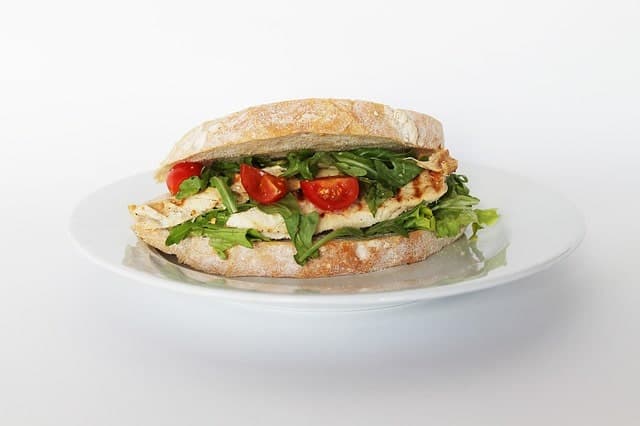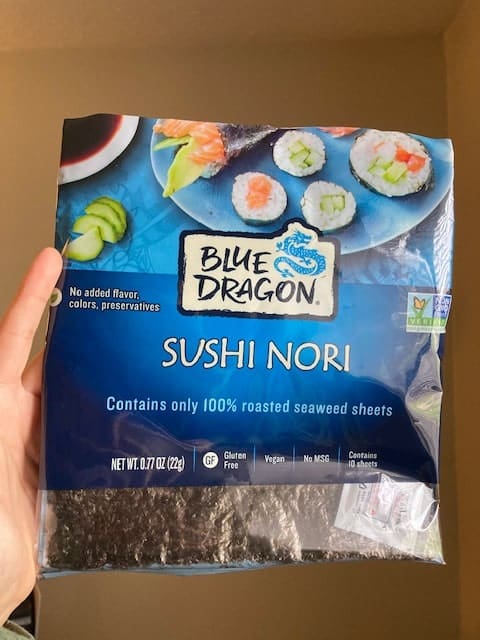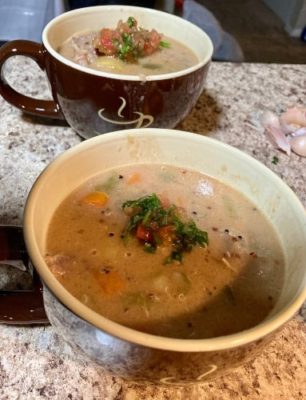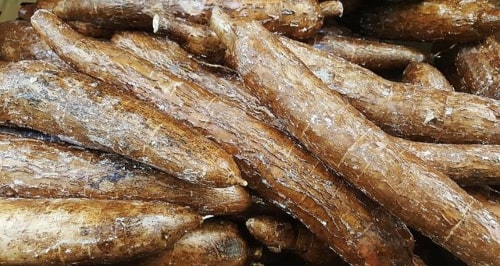Sweet Fried Plantains: What Do You Know About Them?
I’ve always grown up eating sweet fried plantains. I didn’t know the English name for these, however. We always called them plátanos at my house. They look like bananas, but they don’t taste like bananas. In my opinion, they are much sweeter (when consumed ripe). My mom used to either slice plantains diagonally (to increase the surface area for the plantain to cook evenly) and fry them or cut them in half (lengthwise) and bake them in the oven with cinnamon and honey. Plantains are by far my favorite side dish for many Latin American meals.
[There may be affiliate links in this post. Read my disclosure policy to learn more]
What Are Plantains?
As mentioned previously, plantains can often be confused with bananas because they look so similar.
They can be cooked either ripe (the skin will be almost completely black) or green (unripe… the skin will be green).
The green plantains are extremely starchy… like a potato. However, once they have ripened, the starch converts to sugar. The ripe plantains are SUPER SWEET (exactly how I like them)!
A lot of times people chop and fry the green plantains and mash them to make tostones (Puerto Rico) or patacones (Costa Rican).
Tostones and patacones are the same thing but are said differently depending on the country.
On a side note, although ripe plantains (AKA plátanos maduros) are my favorite, I do enjoy eating patacones (mashed green plantains) as an appetizer with some black refried beans as a dip.
FYI: Plátanos maduros go extremely well with gallo pinto.
What Countries Cook and Eat Plantains?
Plantains are cooked in the Caribbean islands, Central America, northern South America, and West and Central Africa.
They’re also used in Southeast Asia and Oceania.
For the longest time, I did not know that they cook plantains in Mexico, but Mexican friends of mine have told me that they do cook them in certain parts of the country and they are called “plátanos machos”.
You’ve got to include the word machos if you’re in Mexico. The reason for this is because plátano in Mexico is a banana (in Costa Rica a banana is called a banano and in Puerto Rico, it’s referred to as guineo).
How to Cook Plantains
Can plantains be eaten raw? To be honest, I’m really not sure! My mom used to tell me not to eat them raw because they will give me a stomach ache, so I never ate them that way.
I would recommend you eat them after they have been cooked. I haven’t known anyone to eat them raw.
As mentioned previously, plantains can be cooked either green (unripe… the skin will be green) or ripe (the skin will be almost black).
You can either boil, steam, or fry green plantains. The skin is not as easy to peel back with your hands as with a banana, so you would need to cut a slit with a knife and peel back with your hands or the knife.
Ripe plantains are a lot easier to peel, but I always use a knife anyway.
Ripe plantains can be fried, boiled, baked, microwaved (I haven’t personally tried this method), steamed, or grilled with the skin still intact.
I will give you some examples of these cooking methods below.
Plantain Health Benefits
Plantains are a good source of magnesium, potassium, Vitamin K, and Vitamin A (Consumer Reports).
An interesting fact about green plantains is that they do not typically digest in the small intestine. They are composed of what’s known as resistant starch, which is a type of fiber that’s not very common.
What this means is that these foods pass through the small intestine and digest in the large intestine. This is good for diabetics because blood sugar levels rise slowly when eating green plantains compared to other starchy foods. Resistant starch also promotes the growth of good bacteria in your gut.
If you choose to cook and eat plantains for health benefits, you have to keep in mind that the starch turns to sugar when you eat ripe plantains.
Also, green plantains lose many of their health benefits if you fry them to make tostones, for example.
The best way to eat plantains for health purposes is to boil them while they’re green and prepare them like you would potatoes.
For example, you can slice the green plantains into chunks and then boil them until they are soft (around 30 minutes).
Then, you can then take them out of the water, peel off the skin (I would recommend that you use a knife for this), and mash them with a little bit of hot water or olive oil. Then, you can top them with sauteed onions and garlic.
Fried Plantains in International Cuisines
Indonesia: Pisang goreng (“Fried Banana”). Deep-fried in coconut oil. It’s snack food.
Philippines: Served with Arroz a la Cubana (Rice, ground meat, and fried egg). *Side Note: I’ve seen people use saba bananas for this dish instead of plantains*
Ivory Coast: Alloco – Sweet fried plantains
West Africa: Dodo (fried sweet plantain)
Western Nigeria: Boli (Bole) – Fried plantains. Served with roasted fish and ground peanuts.
*Side Note: the plantains for bole can be roasted, too.
Puerto Rico
Tostones (AKA banann peze in Haiti; tachinos or chatinos in Cuba; platanos verdes fritos or fritos verdes in the Dominican Republic; and patacones in Colombia, Costa Rica, Ecuador, Honduras, Panama, Peru and Venezuela).
Tostones are cooked green. They are twice-fried and served as a side dish, appetizer, or snack.
They’re made by first peeling the skin and slicing the green plantains into chunks. Then they’re fried. After they have been fried, they are taken out of the pan and are mashed to about half their original size and then fried again. The last step is to take them out of the pan and then season them with salt.
The Freakin Rican has a great YouTube video showing how to make tostones. Check it out!
As mentioned earlier, I loved eating patacones/tostones (when I lived in Costa Rica) as an appetizer. They would typically be served with refried black beans as a dip.
Mofongo
If while you’re in the process of making tostones you change your mind (perhaps you want a more filling meal), you can make mofongo instead!
Mofongo is a Puerto Rican meal made with green plantains. The plantains are peeled, chopped into large chunks, and then deep-fried. Afterward, they are mashed in a pilón.
A pilón is like a wooden bowl with a thick wooden stick that is used to mash food (like plantains).
The green plantains are usually mashed with garlic, olive oil, and chicharrón (deep-fried pigskin with meat attached).
Once everything is mashed, you roll them into a tight ball and eat it with a fork.
By the way, here’s an EXCEPTIONAL video about mofongo that you HAVE to watch by The Freakin Rican Restaurant.
Boiled Plantains in International Cuisines
Ghana: Eto– the plantain can be boiled unripe or ripe. It is boiled then mashed and is typically served with boiled eggs.
Dominican Republic: Mangú – Boiled green plantains that are mashed with hot water. It looks similar to mashed potatoes. Mangú is typically served for breakfast and eaten with fried eggs.
Caribbean: Plantain porridge – Plantains are typically boiled in milk, nutmeg, and cinnamon. This is served for breakfast.
Colombia (Caribbean coast): Cayeye – This dish is a breakfast item that is made from mashed green plantains.
To cook the plantains, you would first chop the plantain into chunks and then cut and peel the skin. You would then boil the plantains until they are soft enough to mash with a fork.
Next, take out the plantains and mash them with a fork like you would when making mashed potatoes.
As the plantains are boiling in the pot, you can make the topping which typically consists of onions, butter, scallions, tomatoes, red bell pepper, garlic, and achiote.
Cayeye is typically served with the vegetable mixture and a fried egg on top.
Take a look at this recipe I found from mycolombianrecipes.com for more information.
For you visual learners, I found a great YouTube video by La Cacerola De Silvana
(heads up… it’s in Spanish).
Plantains as Dessert
I’ve often used ripe plantains to make a dessert.
I slice and then throw away the peel then I slice the plantain lengthwise (halfway… I don’t cut all the way through) and then open it up. Then I sprinkle some cinnamon and pour some honey. Next, I place it into an oven until they are cooked through all the way.
I gotta warn you… this is SOOO sweet! (Perfect for my sweet tooth).
Another popular dessert that can use ripe plantains is the Filipino dessert called Turon (I ABSOLUTELY LOVE this stuff!)
*Side note: I believe they typically use saba bananas, but I have seen some people use ripe plantains.
Filipino turon is sweet, crunchy, and super yummy!
The banana or ripe plantain is sprinkled with brown sugar and wrapped in a spring roll wrapper (or lumpia wrapper) and fried.
It can be eaten by itself or served with vanilla ice cream.
Panlasang Pinoy shares an easy recipe for how to make turon. Also, if you’re a visual learner, I’ve found a Youtube video by Baking with Auntie that shows you how to make turon with ripe plantains.
You should check it out!
Conclusion
I hope you enjoyed learning more about plantains! They are very versatile as they can be eaten green or ripe, for breakfast or dessert. It’s up to you how you want to prepare your plantains 😉
Articles Related to All About Fried Plantains





